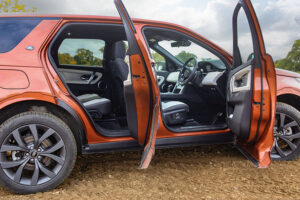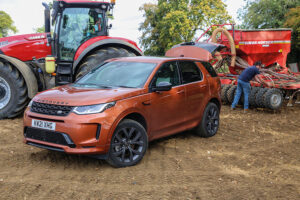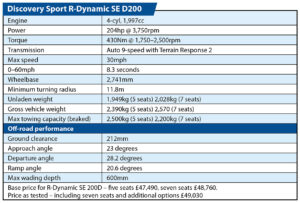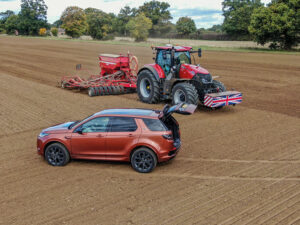Product Review: Land Rover Discovery Sport R-Dynamic SE
25th November 2022
The Discovery Sport joined the Land Rover line-up in 2014 when it replaced the Freelander. It remains extremely popular and that is probably because although it is smaller, easier to drive around town and park, and boasts more stylish lines than the full-size Discovery or the latest Defender, it still has the character and feel of a proper Land Rover. David Williams tried the latest version.

The Discovery Sport joined the Land Rover line-up in 2014 when it replaced the Freelander. It remains extremely popular and that is probably because although it is smaller, easier to drive around town and park, and boasts more stylish lines than the full-size Discovery or the latest Defender, it still has the character and feel of a proper Land Rover. David Williams tried the latest version.
The model provided for the Farmers Guide week-long test was the Discovery Sport R-Dynamic SE with a D200 power unit.
The model line-up features the Discovery Sport as the base version. This comes with a 165hp diesel engine and 2wd, or with the same engine and permanent 4wd in mild hybrid form. The mild hybrid MHEV system stores energy during deceleration and when travelling downhill, then uses the electrical power to assist the diesel engine during acceleration to save fuel and reduce emissions.
The Discovery Sport R-Dynamic comes in permanent 4wd form only, and in SE or better equipped HSE variants. The SE includes a choice of four engines including the D165 – a 165hp diesel with MHEV, as well as the D200 204hp diesel with MHEV, a P250 249hp petrol with MHEV and the most powerful P300e petrol/plug-in hybrid with 309hp.
There are also two ‘Edition’ models – the Discovery Sport Urban and Discovery Sport Black. The Sport Urban has a choice of the D165, D200 or P300e power units and the Sport Black is available only with a P290 290hp petrol engine.
The Discovery Sport R-Dynamic SE we tested comes with a generous standard specification, and the option of five or seven seats.
Interior and comfort
The seats are comfortable, with adequate legroom for a tall driver and front seat passenger. The driver’s seat has 12-way adjustment which makes it easy to achieve a comfortable driving position and once it is set the seat position can be stored within a driver profile for recall at the touch of a button. The Discovery Sport is more compact than the full-size Discovery and with the front seats right back, there is limited leg room in the second-row seats. Moving the front seats forward only slightly makes a big difference to the leg space in the rear, and four adults can undertake long journeys in comfort.
The test vehicle had optional third row seats. When these aren’t needed they fold under the rear load area leaving an almost flat floor, but for use they fold out in seconds complete with full three-point retractable seat belts. Getting into the third row involves tilting the second-row seats forward and entering through either of the two rear doors. The rear-most seats are very shallow and close to the floor making them best suited to use by children. However, making best use of available space in a vehicle is always a compromise, and if the ability to transport seven people safely is needed, then the Discovery Sport provides a practical solution.
The interior is smart but functional. The steering wheel is chunky, and the integral switches are easy to use.
Friendly design
The 10in touchscreen display is easy to use. The driver can select a full-screen display for navigation or divide the screen into sections so that a reduced size map, telephone and media are all displayed simultaneously. The sat-nav system is good and menus are logical and intuitive, so it takes little time to get used to them.
The view through the windscreen and large side windows is good, and the external mirrors are well positioned to negotiate narrow gaps and tight gateways. A 360-degree camera displays an outline image of the car on the centre display along with any objects nearby and, when reverse is selected, there is a clear image from the rear camera on the screen.
The R-Design SE comes with a fixed full-length panoramic glass roof. An internal blind operates electrically, and when it is retracted the interior is a lot brighter and the car feels more spacious.

There is plenty of room for four or five adults to travel in comfort. The test vehicle was a seven-seat version with two additional seats in the rear, but limited leg space means they are better suited to transporting children.
Practicality
With the third-row seats folded away there is a reasonable load area, and this can be further extended by folding the second-row seats forward. The load space is almost flat making it suitable for large, heavy items and there are strong tie-down points to secure loads. The one-piece rear door is hinged at the top. This makes it easy to reach deep inside the boot to place or remove heavy items, but it is more difficult to open the door where space is limited.
There is plenty of storage, including large pockets in the front and rear doors. The glovebox is shallow, but there is a storage box with a lid in the centre console, a large open storage compartment in front of the gear selector and two large drinks holders also in the centre.
Second and third row seat occupants also have drinks holders.
The test vehicle didn’t have a tow bar but judging by the performance on hilly terrain the D200 power unit will easily handle trailers up to the 2,200kg maximum. Trailer stability assist is standard.
Other practical features include puddle lights that assist while entering and exiting the car in the dark, power folding external mirrors with automatic dimming on the driver’s side and Blind Spot Assist which displays a subtle but clear warning in the mirrors if a car or other object is in the blind spot beside the vehicle.

The Discovery Sport is a roomy and comfortable family car, but impressive off-road capability including plenty of ground clearance means it will also transport people and equipment around the farm when other 4×4 vehicles aren’t available.
Performance and handling
The D200 engine is smooth and quiet. On the road, the Discovery Sport cruises easily at 70mph, and there is plenty of acceleration to pull away briskly from junctions in heavy traffic. Most of the time, the nine-speed automatic gearbox changes so smoothly that the gear shifts are not noticeable except under rapid acceleration, but in some situations when changing speeds frequently in heavy traffic, a new gear is selected and the drive re-engages with a jolt.
Selecting manual gear shifting instead of auto is achieved by pushing the gear selector to the left. Moving the lever backwards and forwards changes up and down through the gears, or the gear selector paddles behind the steering wheel can be used instead. Returning the lever to the right position re-selects automatic mode. There is also a temporary manual override function. Operating the steering wheel paddles selects manual mode with manual shifting for a limited time after which automatic mode resumes.
The week-long test included a mix of long motorway journeys as well as travel on narrow rural roads and rough farm tracks, and the flexible engine and transmission performed well.

Farmers Guide put Land Rover’s Discovery Sport through its paces on- and off-road during a
week-long test.
Adapts to terrain
The Discovery Sport comes with Terrain Response 2, which constantly monitors the driving conditions and terrain and configures the engine and transmission to suit. Although the system is extremely capable, there is also the option to select the driving mode manually. Settings include Comfort; Dynamic; Eco; Grass/Gravel/Snow; Mud & Ruts; Sand and Wade sensing. Most of the time we had Eco mode selected which was adequate in almost every situation but selecting the soft sand setting when driving across freshly cultivated ground meant lower gears were selected with higher engine revs, and the vehicle became more responsive.
Additional driver assistance features include All Terrain Progress Control, Hill Descent Control and Hill Launch Assist, although the car is so capable that for most situations the standard automatic settings are adequate.
It is a very easy car to drive and it feels compact and nippy on narrow, winding roads. The ride quality is good and there is little roll on corners. The suspension is firm but comfortable and it copes well travelling along pot-holed back roads and rutted farm tracks at speed. The tyre equipment was standard for this model and version, and the Pirelli All-Season 235/50R20s were quiet and gripped well on and off road.
Overall, during the test week, the Discovery Sport achieved 39.8mpg average fuel consumption, and on a longer motorway journey it exceeded 43mpg.

The test vehicle had Land Rover’s D200 diesel engine which develops 204hp and 430Nm of torque between 1,750–2,500rpm. This is probably the best choice for farm use as there is plenty of power for relaxed towing, but it remains surprisingly economical.
Land Rover Discovery Sport R-Dynamic SE: The verdict
The Discovery Sport is unlikely to be chosen as the main farm transport vehicle. It lacks the rugged practicality, capacity or towing ability of a typical farm pick-up or the bigger Land Rover Defender or Discovery models. However, it is extremely capable off-road, and its ability to carry loads and tow trailers across wet, slippery grassland, handle deep rutted tracks and cross field edge plough furrows means it can contribute to farm transport activities when other vehicles aren’t available.
It’s a large and comfortable car which is suitable for transporting a farm or contracting team between work locations, doing the school run or taking families on longer journeys – although the third-row seats lack the leg room needed for adults. Folding the second-row seats forward creates a large, flat load area capable of transporting parts and equipment.
The Discovery Sport performs well on the road, and as the Farmers Guide test demonstrated, the D200 version – which seems the best option for farm use, returns impressively good fuel consumption. The HSE upgrade comes in at just under £2,500 more than the SE, and that adds front fog lights, an improved sound system, 14-way electric driver seat adjustment, an adjustable rear seat and Configurable Dynamics which allows aspects of the car’s handling including steering and suspension to be adjusted to suit the driver’s preference.
The car has a chunky feel, it is ruggedly made and, although it is at the lower end of Land Rover’s line-up, it remains worthy of the badge.

